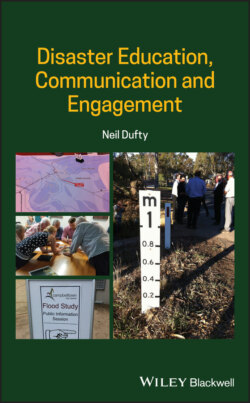Читать книгу Disaster Education, Communication and Engagement - Neil Dufty - Страница 22
2.3.1 Public Participation Spectrum
ОглавлениеThe key message for designing engagement processes is to avoid promising a level of participation and power that is never intended to be given, or designing processes that claim to be empowering, but merely offer ‘token’ levels of participation. Pretty and Hine (1999) have developed a typology of ‘participation’ to differentiate actions according to the level of power agencies wish to devolve to participants in determining outcomes and actions.
The International Association for Public Participation (IAP2) has developed the Public Participation Spectrum (IAP2 2019) to demonstrate the possible types of engagement with stakeholders and communities. The spectrum is widely used and is quoted in most community engagement manuals.
According to the spectrum there are five types of engagement:
1 Inform – to provide stakeholders with balanced and objective information.
2 Consult – to actively seek community views and input into policy, plans, and decisions.
3 Involve – to deliberately put into place a method to work directly with stakeholders throughout the process.
4 Collaborate – to partner with the community in each aspect of the decision.
5 Empower – to place final decision-making in the hands of the public.
As one moves through the spectrum from ‘inform’ through to ‘empower’ there is a corresponding increase in expectation for public participation and impact. In simply ‘informing’ stakeholders there is no expectation of receiving feedback, and consequently there is a low level of public impact. At the other end of the spectrum, ‘empowering’ stakeholders to make decisions implies an increase in expectations and therefore an increased level of public impact.
The IAP2 Spectrum has been widely used to guide the design of disaster-related community engagement. For example, the Australian Government has provided guidance (Australian Emergency Management Institute 2013) that uses the spectrum because ‘different types of engagement and levels of community involvement are required for different phases of an emergency’.
It could be argued that ‘empower’ is the only true level of engagement as it enables communities to have power in decision-making (Mosse 2003). Mansuri and Rao (2004) distinguish between ‘organic participation’, which originates from the people's own initiative to be active in some aspect of social change, and ‘induced participation’, which is the normal type that arises when an organisation wants to implement a project with the local people and participation is induced by the outside organisation. Arnstein (1969) argued that ‘participation without redistribution of power is an empty and frustrating process for the powerless’. For disaster-related community engagement ‘this may be overcome by an approach that builds community-wide trust and meets the real needs of those at risk’ (International Federation of Red Cross and Red Crescent Societies 2014b).
